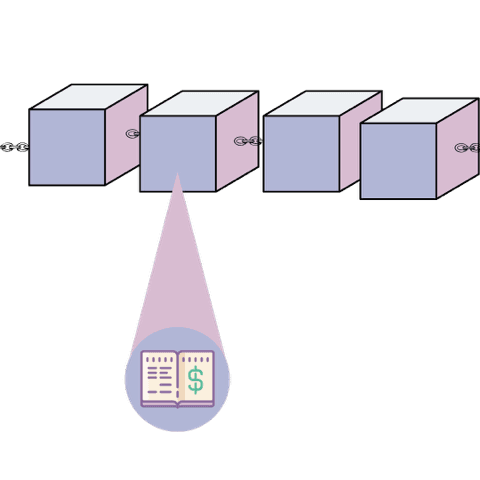Blockchain
Introduction
Inevitably, the internet was the inception of the technology revolution. It changed everything – the way we research (Google), shop (Amazon), entertain ourselves (Youtube), connect with one another (Facebook), and make payments (Blockchain).
Okay, but what is a blockchain?
As defined in the previous topic, cryptocurrency doesn’t require a middleman to transfer funds from one user to another. The technology that cuts out this intermediary regarding payments and the transfer of value is blockchain.
In centralized systems, like a bank’s database, the bank is responsible, has authority to maintain its data, and ensures security. They are responsible for updates, licenses, and more.
Centralized systems rely on people to operate, while decentralized systems don’t. Blockchain users rely solely on the technology they code to make the decisions instead. Blockchains’ decentralized systems have no single point of authority. Therefore, the technology and network participants called nodes must be approved and update transaction records and ledgers. Each blockchain has its own way of running but a common way to explain nodes is through the Bitcoin blockchain. This blockchain relies on nodes which are computers running software that authenticate transactions occurring on the Bitcoin blockchain. For transactions to be processed/authenticated, several nodes have to agree on the state of the transaction, technically known as ‘reaching consensus’.

Who invented it?
Blockchain was first introduced by a person or group who went by the pseudonym, Satoshi Nakamoto. Satoshi created the first blockchain system along with Bitcoin. It’s also worth noting that pre-Satoshi, several notable individuals made the creation of Satoshi’s blockchain possible:
Stuart HaberW
Scott Stornetta
Nick Szabo
Hal Finney
If blockchain is kept secure by computers, could someone hack into blockchain?
The consensus mechanism (the way decisions are made about transactional data) and immutable nature of data that lives on the blockchain make the technology secure and practically impenetrable. Wallets, however, can be hacked, so it’s imperative to have very secure passwords like with any account that holds money.
This is a great quote to further understand the importance of blockchain:
“For the first time, there is a way for one Internet user to transfer a unique piece of digital property (currency/money) to another internet user so that the transfer is guaranteed to be safe and secure, everyone knows that the transfer has taken place, and nobody can challenge the legitimacy of the transfer. The consequences of this breakthrough are hard to look past.” — Marc Andreesen
What can blockchain technology influence at scale?
Establishing Digital Identity
In any society, the question of identity is fundamental. Nowadays, it’s fair to say that a significant part of our identities exists digitally. What is a digital identity? It could be your social media handle, your IP address, or even the sum of your online information, including passwords, records, and history.
As it stands, digital identities are issued and subsequently stored by centralized entities, leading to issues with accessibility, data security, and fraud. However, the emergence of blockchain and the rise of decentralized systems has ushered in a new way of storing identities. Through blockchain, the concept of self-sovereign identity is now a possibility. Self-sovereign identity means instead of a website storing your personal information, you store it on your own device.
There’s a lot to cover on this topic, so check out this great article by Consensys.
Data Management
The Facebook-Cambridge Analytica case is one of the best examples of data mismanagement. Up to 87 million profiles were harvested, without permission, for use in targeted political advertisements. The data was vulnerable due to mismanagement from Facebook, which was responsible for maintaining and ensuring the security of their own internal databases.
Blockchain prevents the above from happening because data cannot be changed or tampered with (immutable), and there is no room for human error (decentralized).
Commerce
How we engage with financial products is changing rapidly thanks to the boom in blockchain-based applications. The best example of this can be seen in the DeFi space, the umbrella term used to describe decentralized finance applications. The DeFi space makes it easy for users to borrow, transact, and invest in decentralized businesses.
Business Efficiency
Blockchain technology has increased business efficiency by reducing the number of people involved in transactions and in turn, reducing the cost of doing business.
Community Structures
Blockchain has created new community structures by introducing Decentralized Autonomous Organizations (DAO). DAOs are represented by rules enforced on a blockchain and not by a central entity. After rules are embedded, managers are no longer needed, thus removing any bureaucracy.
The different types of blockchains
Blockchains are often categorized into four groups
Public Blockchains
Public networks are permissionless blockchains maintained by public participants. They have no central authority which allows anyone to become a node. (Bitcoin, Ethereum, Litecoin, etc.) Examples include the following:
Bitcoin
Ethereum
Litecoin
Dash
Zcash
Monero
Dogecoin
Decred
Horizen
DigiByte
Ravencoin
And many more.

Private Blockchains
Private blockchains, such as Corda, are referred to as ‘permissioned’ because the network is only available to “permissioned” users.

Hybrid Blockchains
A single organization controls hybrid blockchains, but a public blockchain is required to perform transactions.

Consortium Blockchains
Consortium blockchains are private blockchains governed by a group of organizations instead of one single entity, which is usually the case of private blockchains.

To Recap
A Blockchain maintains a record of each transaction and removes the need for a middleman or central authority when trading cryptocurrency. Because of its versatility, it can be used for many purposes including, data management, establishing a digital identity, and commerce. To fulfill these functions, various types of blockchains exist. An example is public blockchains, which house coins such as Bitcoin.
